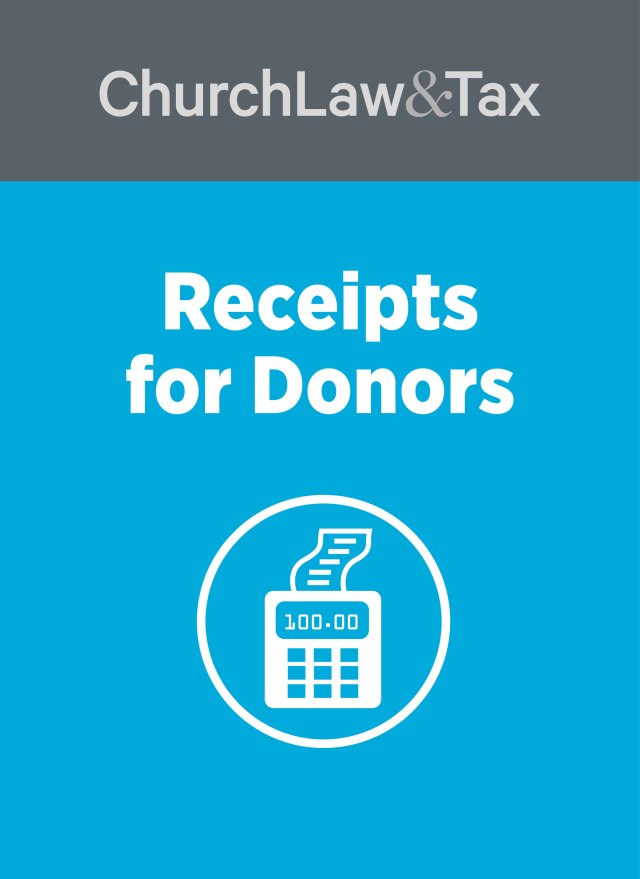A church member donates $2,000 to her church during the first six months of the year. She then becomes upset with the pastor and begins attending another church. She contacts the business administrator of her former church and demands a refund of all the contributions she made earlier in the year. How should the administrator respond?
Start by testing your knowledge. Then read on for a summary of this topic.
- Donors generally have the right to demand a refund of contributions they make to a church, if they do so within the same year as the contribution.
True or False - While a church may not be legally required to refund donors’ contributions in most cases, it is a good practice to do so.
True or False - A donor makes undesignated contributions to the church throughout the year amounting to $5,000. She becomes upset with the church leadership, and begins attending another church. She asks to have her contributions for that year refunded so she can donate them to the church she presently is attending. The church is not legally required to comply with this request.
True or False - A church creates a building fund to finance the construction of a new building. Over a 3-year period it receives contributions of $100,000 that are designated for this fund. The church can identify every donor who made a contribution to the fund, and the amount of each contribution. The church decides to abandon the building program. It should ask donors to the fund if they want their contributions returned, or if they want to redesignate them for another purpose.
True or False - Matt donated $5,000 to a church project last year, and deducted this amount on his tax return. This year, the church abandons the project, and Matt asks that his contribution be returned. If the church complies with this request, it should inform Matt that he will need to file an amended tax return for the previous year so that the deduction he claimed can be eliminated.
True or False - Sometimes donors ask for a refund of specified contributions. For example, John donates $10,000 to the church building fund, and the church board votes to abandon the building project later that year. John asks the church business administrator to refund his $10,000. Or, a family quits attending Church A midway through the year, and begins attending Church B. The family asks the church business administrator of Church A for a refund of all of their contributions. How should these requests be handled?
- Answering these kinds of questions begins with an understanding of the fact that a charitable contribution is a gift, and, like any gift, is an irrevocable transfer of a donor’s entire interest in the donated cash or property. Since the donor’s entire interest in the donated property is transferred, it generally is impossible for the donor to recover the donated property. As we will see, there are a few exceptions to this general rule.
- Undesignated contributions
- Most charitable contributions are undesignated, meaning that the donor does not specify how the contribution is to be spent. An example would be a church member’s weekly contributions to a church’s general fund. Undesignated contributions are unconditional gifts. A church has absolutely no legal obligation to return undesignated contributions to a donor under any circumstances.
- Designated contributions
- Often a donor will make a “designated” contribution to a church. That is, the donor designates how the contribution is to be spent. For example, a donor contributes a check in the amount of $1,000 and specifies that it be used for missions, or the building fund, or some other specific project. Many courts have ruled that such designated contributions are held by the church “in trust” for the designated purpose. So long as the church honors the designation, or plans to do so in the foreseeable future, it has no legal obligation to return a donor’s designated contribution.
- What if a donor contributes money to a church’s building fund and the church later abandons its plans to construct a new facility? Such contributions are conditioned on the church pursuing its building program. If it abandons the program the contribution is revocable at the option of the donor. Should the church refund designated contributions to donors under these circumstances? There are a number of possibilities, including the following:
- • Donors can be identified. If donors can be identified, they should be asked if they want their contributions returned or retained by the church and used for some other purpose. Ideally, donors should communicate their decision in writing to avoid any misunderstandings. Churches must provide donors with this option in order to avoid violating their legal duty to use “trust funds” only for the purposes specified.
- A church should send a letter to donors who request a refund of a prior designated contribution informing them that (1) there may be tax consequences, (2) they may want to consider filing an amended tax return to remove any deduction claimed during any of the three previous years as a result of their designated contribution, and (3) they should discuss the options with their tax advisor.
- • Donors cannot be identified. A church may not be able to identify all donors who contributed to the building fund. This is often true of donors who contributed small amounts, or donors who made anonymous cash offerings to the building fund. In some cases, designated contributions were made many years before the church abandoned its building plans, and there are no records that identify donors. Under these circumstances the church has a variety of options.
- One option would be to address the matter in a meeting of church members. Inform the membership of the amount of designated contributions in the church building fund that cannot be associated with individual donors, and ask the church members to take an official action with regard to the disposition of the building fund. In most cases, the church membership will authorize the transfer of the funds to the general fund. Note that this procedure is appropriate only for that portion of the building fund that cannot be traced to specific donors. If donors can be identified, then use the procedure described above.
- Another option is to ask a court for authorization to transfer the building fund to another church fund. Over 40 states have adopted the Uniform Management of Institutional Funds Act, and this Act permits churches to ask a civil court for authorization to remove a restriction on charitable contributions to “endowment” funds in some situations. The Act provides:
- If written consent of the donor cannot be obtained by reason of his death, disability, unavailability, or impossibility of identification, the governing board may apply in the name of the institution to the [appropriate] court for release of a restriction imposed by the applicable gift instrument on the use or investment of an institutional fund … . If the court finds that the restriction is obsolete, inappropriate, or impracticable, it may by order release the restriction in whole or in part.
- Other options are available. Churches should consult with an attorney when deciding how to dispose of designated funds if the specified purpose has been abandoned or is no longer feasible.
- Some courts have ruled that a donor has no legal “standing” to enforce a designated gift to charity. The reason for this rule is simple—a charitable contribution is a gift, and a gift is a transfer of all of a donor’s “dominion and control” over the donated property. Allowing a donor to enforce a designated gift is not legally possible because the donor has no remaining interest in the gift. This is true even if the gift was “designated.” The fact remains that a designated gift is held by a church or charity “in trust” for the specified purpose. The trust may be expressed in a written trust instrument, but usually no instrument exists and the trust is implied. While the donor may not be able to enforce such a “trust,” this does not mean that a church or charity can ignore it. Some courts have ruled that the state attorney general can enforce a trust created by a designated gift, and so can any other person with a “special interest” in the trust. While this does not ordinarily include donors, their families or heirs, or even beneficiaries of the gift or trust, it may include “fiduciaries” (such as a trustee of a written trust).
- • Some donors can be identified, and some cannot. In most cases, some of the building fund can be traced to specific donors, but some of it cannot. Both of the procedures summarized above would have to be used.
- Churches that solicit funds for designated projects face difficult choices when they abandon the project and are left with the task of disposing of funds donated for that project. These problems can be avoided if the church simply includes a statement similar to the following when soliciting funds for a specific project: “By contributing to this project, donors acknowledge that the church has the authority to apply contributions designated for this project to another, related purpose in the event that the project is canceled.” Such a statement should be printed on special offering envelopes used for the project, or on any other materials so long as they provide adequate notice to donors of the policy and reflect donors’ consent to it.
- Quiz answers: 1) F 2) F 3) T 4) T 5) T


